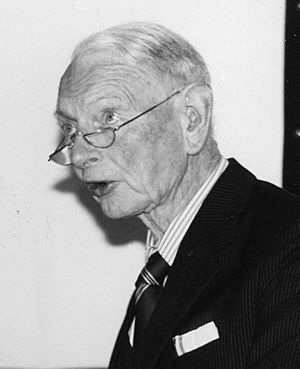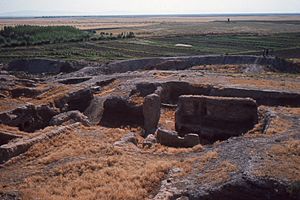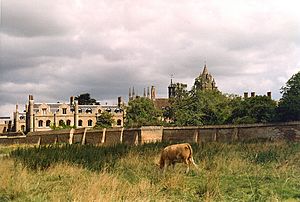Grahame Clark facts for kids
Quick facts for kids
Sir Grahame Clark
|
|
|---|---|
 |
|
| Born |
John Grahame Douglas Clark
28 July 1907 Bromley, England
|
| Died | 12 September 1995 (aged 88) Cambridge, England
|
| Citizenship | United Kingdom |
| Alma mater | Peterhouse, Cambridge |
| Scientific career | |
| Institutions |
|
Sir John Grahame Douglas Clark (1907–1995) was a famous British archaeologist. He was also known as J. G. D. Clark. He focused on the Mesolithic period in Europe. This is also called the Middle Stone Age. He also studied how ancient people lived and used their environment.
Clark spent most of his career at the University of Cambridge. He was a professor of archaeology there. He also led Peterhouse college for a few years. He was known for his work on prehistoric economies. He also studied how ancient people interacted with their environment.
Contents
Discovering Archaeology
Early Life and Interests: 1907–1927
John Grahame Douglas Clark was born on July 28, 1907. He grew up in Kent, England. His father was a stockbroker and a soldier. Sadly, his father died in 1919 after World War I. Grahame was raised by his mother and an uncle.
His family moved to Seaford when he was young. He loved collecting prehistoric flint tools there. These were stone tools made by ancient people. This hobby sparked his interest in archaeology.
Clark went to Marlborough College in Wiltshire. He joined the school's Natural History Society. He was nicknamed "Stones and Bones" because of his interest. He also loved butterflies and moths. He visited an archaeological dig at Windmill Hill. He also started reading Antiquity, an archaeology magazine. By the time he left school, he knew he wanted to be an archaeologist.
University Studies: 1927–1934
In the 1920s, few universities taught archaeology. Clark tried for a scholarship at University of Oxford but didn't get it. He then applied to Peterhouse at the University of Cambridge. He was accepted as a student who paid his own fees. He started his degree in 1927.
He first studied history. He learned about economic history. This helped him later study how ancient societies managed their resources. He also kept doing his own archaeology research. He published articles on prehistoric stone tools.
In 1928, Clark began studying archaeology at Cambridge. He learned from famous archaeologists. He also helped with digs. He worked at Whitehawk Neolithic causewayed camp and The Trundle in Sussex. There, he met other archaeologists who became his friends. He graduated in 1930 with top honors.
Clark then started his PhD. He focused on the Mesolithic period in Britain. This was the Middle Stone Age. Not much was known about it then. He traveled to Denmark and Sweden to learn more. He then studied stone tools from museums and private collections. He mapped where these tools were found.
His research became his book, The Mesolithic Age in Britain (1932). It was highly praised. The book discussed how Mesolithic people adapted to climate change. It also used pollen analysis to understand ancient plants. This showed his interest in the environment. He finished his PhD in 1934.
Clark also helped start the Fenland Research Committee in 1932. This group studied the East Anglian Fenlands. They dug at places like Plantation Farm. This helped them understand the history of the Fens. It also showed how different fields of study could work together.
In 1933, Clark became the editor of the Proceedings of the Prehistoric Society of East Anglia. In 1935, he helped change the society's name to The Prehistoric Society. This made it a national group. He edited its journal until 1970.
Archaeological Career
Early Career and World War II: 1935–1945
In 1935, Clark became an assistant lecturer at Cambridge. He taught about how climate affects history. He trained many students who became important archaeologists. He also helped set up the Cambridge University Archaeology Field Unit.
He led digs at Mildenhall Fen and Farnham. These digs helped find Bronze Age tools. In 1936, Clark married Gwladys Maud "Mollie" White. She was also an archaeology student. They traveled to Norway, Sweden, and Germany to see archaeological sites.
In 1936, Clark published The Mesolithic Settlement of Northern Europe. This book showed his growing interest in how people lived in their environment. In 1939, he published Archaeology and Society. This textbook explained how archaeology helps us understand past societies. He believed archaeology could promote peace. He also criticized how some countries used archaeology for nationalistic ideas.
During World War II, Clark joined the Royal Air Force Volunteer Reserve. He worked on interpreting aerial photographs. This helped him stay connected to other archaeologists. He also continued to write articles. He wrote about topics like ancient fishing and whale hunting. He used old folk stories to understand archaeological finds.
Post-War Discoveries: 1946–1951
After the war, Clark returned to Cambridge as a lecturer. He published From Savagery to Civilisation in 1946. This book discussed how societies developed. He also traveled around Europe to study rural and fishing communities.
In 1950, he became a Fellow at Peterhouse college. He became friends with economic historian Michael Postan. Postan's work on farming inspired Clark to rethink Neolithic farming. In 1951, Clark wrote a chapter on using folklore to understand prehistory. He also wrote Prehistoric Europe: the Economic Basis. This book explored how ecology affected ancient economies. It became one of his most important books.
Clark heard about a Mesolithic site called Star Carr in North Yorkshire. He visited the site in 1948. He realized it was an important settlement. He led three seasons of excavation there from 1949 to 1951. The project involved botanists and other scientists. This made it a very modern dig for its time.
He published his findings quickly. The main book about Star Carr came out in 1954. It became a classic in archaeology. It influenced many other digs, especially in the United States.
Leading Archaeology at Cambridge: 1952–1972
In 1952, Clark became the Disney Professor of Archaeology at Cambridge. This was a very important position. He focused on research and encouraged his staff to do the same. He also encouraged students to travel abroad for research.
He served on many important committees. He was elected a Fellow of the British Academy in 1951. He gave lectures about prehistoric economies. His last major excavation was at Hurst Fen in Suffolk. This dig helped us learn more about the Neolithic period in England.
Clark's work brought him international attention. He visited the United States in 1952. He met American archaeologists like Gordon Willey. In 1957, he taught at Harvard University. He also visited famous sites like Lascaux cave in France.
In 1959, Clark became President of the Prehistoric Society. He wanted archaeology to focus more on global prehistory. This led to his book, World Prehistory: An Outline (1961). It was a success and made him even more well-known.
He became interested in Greek prehistory. He visited the Neolithic site of Çatalhöyük in Turkey. He also wrote about how farming spread across Europe from Greece. In the 1960s, he traveled to New Zealand and Australia. He learned about Maori prehistory and visited indigenous communities. He also lectured in the U.S.
In 1969, he published a system for classifying stone tools. This system is still used today. In 1970, he retired as editor of the Proceedings. He received many awards for his work. These included the Erasmus Prize and a British knighthood.
Later Life and Legacy: 1973–1995
Clark retired as Disney Professor in 1974. From 1973 to 1980, he was the Master of Peterhouse college. He continued to write books. Some of his later books explored ideas about human identity and art.
In 1990, he received the Erasmus Prize. He shared the prize money with the British Academy and the Prehistoric Society. This helped them create their own awards. In 1992, he was given a knighthood.
Sir Grahame Clark passed away on September 12, 1995, in Cambridge. He is remembered as one of the most important prehistorians of his time. He changed how archaeologists thought about ancient economies and environments.
Clark's Archaeological Approach
Clark was very interested in what happened in the past. He focused on how ancient people lived. He studied their economies and social patterns. He believed that all humans are connected. He thought human differences came from how people adapted to their environments.
He used new scientific methods to analyze archaeological finds. He also used folklore and ethnography to understand ancient ways of life. He was careful not to use these ideas without thinking. He believed they were most useful when there was a clear link between old and new communities.
Clark saw the rise of "New Archaeology" or processual archaeology. This new way of thinking changed the field. Clark stayed out of these debates. He believed that archaeology was not just a pure science. He thought it was also about understanding people.
Personal Life
Clark was a tall and quiet man. He was very private about his feelings. Some people found him distant. But his colleagues also said he was kind. He was sometimes awkward with his students. His lectures were not always exciting.
Clark was very competitive. He wanted to be recognized for his work. He had many acquaintances but few close friends in archaeology. He often talked about his own research.
He was one of the most important British archaeologists of his time. He had a long-term disagreement with another archaeologist, Christopher Hawkes. Hawkes believed that cultural changes came from people moving into Britain. Clark thought changes happened more from people developing ideas within Britain.
Clark was a practicing Christian. He was also politically conservative. He believed in the importance of individual achievement. He thought that people from different cultures could work together to solve problems.
Clark was devoted to his family. His wife, Mollie, was a big part of his academic life. They lived in Cambridge. He loved gardening and sailing. He also enjoyed visiting art galleries. In his later years, he collected art, Chinese porcelain, and Asian jade.
Images for kids







